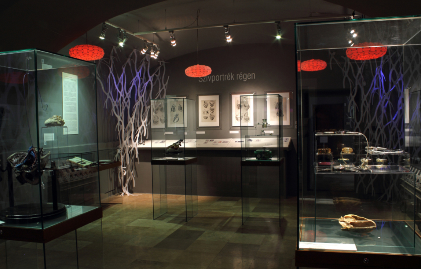The heart beats for you
Exhibition
The human heart, one of our most interesting, but definitely most important organs is put into the limelight in the latest exhibition of the Semmelweis Medical History Museum.
| Hermann Veronika |
2012-08-22 16:08 |
 The total length of the veins of the human body is more than 95 000 kilometers : they could easily get around the Earth. In the centre of our blood circulation there is the pump, which keeps the whole system alive: the heart. In most civilizations it was metamorphosed and means much more than just the symbol of the most important organ. In every language there are several denominations that make the heart the bearer of positive rhetorical sentiments. The human heart can be broken, it can sing, smile, dance, its anthropomorphized image is the central theme of thousands of artistic creations.
The total length of the veins of the human body is more than 95 000 kilometers : they could easily get around the Earth. In the centre of our blood circulation there is the pump, which keeps the whole system alive: the heart. In most civilizations it was metamorphosed and means much more than just the symbol of the most important organ. In every language there are several denominations that make the heart the bearer of positive rhetorical sentiments. The human heart can be broken, it can sing, smile, dance, its anthropomorphized image is the central theme of thousands of artistic creations.
In the depth of blood-streams
Instead of well-known metaphors the Semmelweis Medical History Museum’s exhibition „heartbeat” presents the organ and past of the disciplines that deals with the heart: cardiology and cardio-surgery. In the exhibition halls white net-like plastic veins are hung, symbolizing circulation. Over the glass the visitors find themselves in the middle of a blood-stream, thanks to the witty, conceptual but comprehensible installation.
 Heart-murmur
Heart-murmur
The heartbeat is actually the sound of the contraction and the relaxing of the cardiac muscle and noise of the fluxation of the blood. A healthy heart is not only the most important but the most beautiful organ: its shape, form, and color make it similar to a work-of-art. Despite the rapid development of surgery and medicine heart was regarded with awe and dread. Those, who tried to meddle with its functioning failed most of the time. The exhibition presents the most significant milestones. The way of the blood in the smaller and bigger blood circle and in the heart itself was first described by an English doctor, William Harley, in 1628. The development of medicine was much more radical than during the previous several centuries. The first heart transplant was completed by professor Christian Neethling Barnard in 1967. In Hungary the same operation took place in 1992 by professor Zoltán Szabó at the Cardio-Surgery Clinic of Semmelweis University.
The exhibition consisting of 3 halls presents the milestones of cardio-therapy, its instruments and other relics. It is an inspirational show that make visitors think about the importance of the most important. It is a homage not only to cardiology, but to all doctors and medical workers, who, sometimes in awful circumstances, do everything they can so that our hearts could keep on beating.
Heartbeat. The Past And Present of Cardiology.
The exhibition can be visited until october 25th. For the website of the exhibition click here!